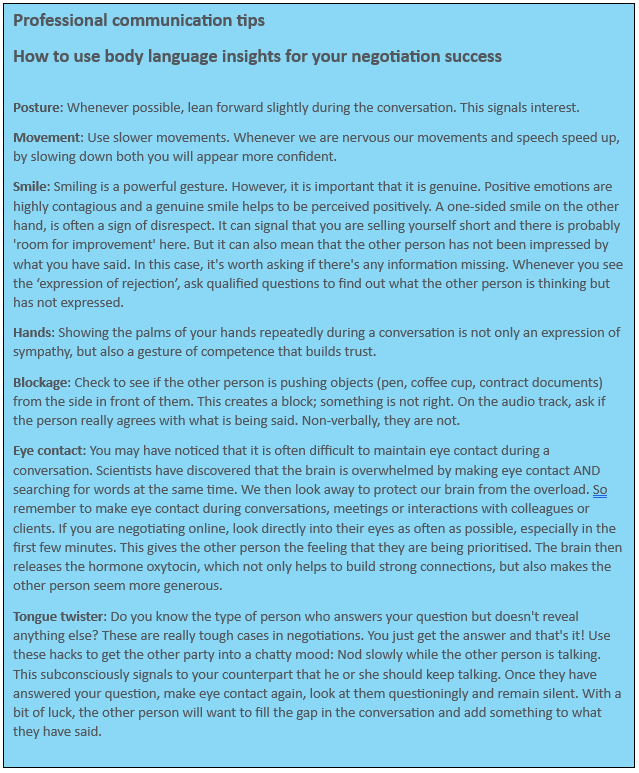Online negotiations have become the ‘new norm’. Video calls offer huge advantages in terms of cost and time efficiency, but also come with their own unique set of challenges compared to in-person negotiations.
Here are 5 key challenges which are faced during online communications, together with practical approaches on how to cope with them and how to prepare yourself and your team:
1. Miscommunication
Challenges: Video calls often limit or remove many of the nonverbal cues we rely on in face-to-face meetings. Only 45% of communication is actually interpreted through words and vocal cues, meaning our ability to gauge someone’s reactions by their body language is removed and we can come unstuck. Likewise, it can be harder to express your own ideas as effectively – this leads to a higher probability of miscommunication.
Approach and Preparation: As video reduces our nonverbal senses, be prepared to tune into the tone of the persons voice, the way they express themselves and their facial expressions more than usual. Practice asking open-ended questions, thereby prompting the other party to provide more detailed responses and reveal their feelings and concerns. Also probe their engagement; if they consistently respond quickly and with enthusiasm, it may indicate a high level of interest or commitment.
When something is unclear, don’t hesitate to ask for clarification. Furthermore, remember ‘it’s not what you say it’s how you say it’ – with so much body language removed what you say can easily be misconstrued too. Asking for feedback will give you the chance to address any concerns and ensure you are on the same page at all times. Making use of the additional tools on offer such as visual aids and shared documents and screens is also helpful when trying to clarify complex topics and reduce misunderstanding.
2. Technical Delays or Disruption
Challenges: Technical problems, such as slow internet connection, dropped calls, poor video quality, or audio issues, can disrupt the negotiation process and lead to frustration. Participants may need to spend valuable time troubleshooting these problems.
Approach and Preparation: Establish clear expectations for the negotiation process from the outset including timelines, response times, and communication protocols. This can help prevent misunderstandings related to delays. Create and share an agenda for the negotiation, outline topics to be discussed and the estimated time allocated to each. Stick to the agenda to maintain focus and efficiency.
Allocate sufficient time for the negotiation; rushing due to time constraints can lead to rash decisions and complications later down the line. Be flexible and understanding when technical or scheduling issues arise. Try to offer solutions, reschedule or extend the negotiation if needed.
While it is easy to become frustrated when a technical hitch occurs, it is essential to remain calm; reacting negatively can exacerbate misunderstandings and hinder the negotiation. To reduce the risk of technical problems within your control, test connections and equipment in advance and have technical support available if required. A backup plan for technical issues, such as switching to a phone call or having an alternative video platform can be a great idea.
3. Data Security, Privacy and Digital Signatures
Challenges: Sharing sensitive information and documents electronically can raise concerns about data security and privacy, with some platforms making the process complex and cumbersome.
Approach and Preparation: here are a few suggestions to address this challenge:
- Select a reputable and secure communication platform which offers encryption, data protection, and robust security features.
- Train all participants on best practices for data security and privacy. They should understand how to recognise phishing attempts and other security threats.
- Ensure both parties use secure and trusted networks and avoid using public Wi-Fi or unsecured networks.
- Establish clear data retention policies.
- Your electronic signature platform should comply with relevant legal requirements and regulations, such as the Electronic Signatures in Global and National Commerce (ESIGN) Act in the United States or the European Union’s eIDAS regulation.
- Communicate in advance the process of signing digitally to all parties to flush out any areas for delay, including consent, methods of authentication, audit trail and post execution confirmation.
4. Distractions and Susceptibility
Challenges: As a result of an increasingly digitalised lifestyle, humans are estimated to lose concentration after eight seconds (one second less than the average attention span for the notoriously ill-focused goldfish). Therefore, participants in online negotiations may be more susceptible to distractions and multitasking – checking emails, social media, or working on other tasks for example.
Approach and Preparation: to help focus each party, clearly communicate the objectives, agenda and what each attendee’s role is in advance. Plan for short, scheduled breaks during longer negotiations giving participants opportunities to briefly check emails or address other tasks without feeling the need to do so during the meeting.
Keep discussions focused and concise and encourage active participation. Avoid long-winded or repetitive conversations to prevent boredom and distraction. Encourage the use of video during negotiations, as it makes participants feel more accountable and reduces temptation to multitask. Periodically check in with participants to ask for their thoughts and input. This can help re-engage those who may have become distracted.
5. Trust and Emotional Connection
Challenges: Building trust and rapport is often more challenging online because it’s harder to establish a personal connection. In-person negotiations allow for natural small talk and social interactions that help build relationships – these are often sacrificed during video meetings.
Approach and Preparation: Being authentic is crucial in building a personal connection. As we become more adjusted to online communication, it should be easier to avoid an overly formal or impersonal approach. Using video rather than audio helps build this connection.
To a reasonable extent, you may also want to share some personal information about yourself – such as your interests, background, or experiences – as you would in a face-to-face meeting. If done appropriately this will make you more relatable and will support a successful negotiation.

Authors: Tobias Heining (Business Development – Europe, Martyn Fiddler Aviation) and Saskia Naumann (expert and coach for non-verbal communications and body language)
Editor: Heather Gordon, Legal Director, Martyn Fiddler Limited.



